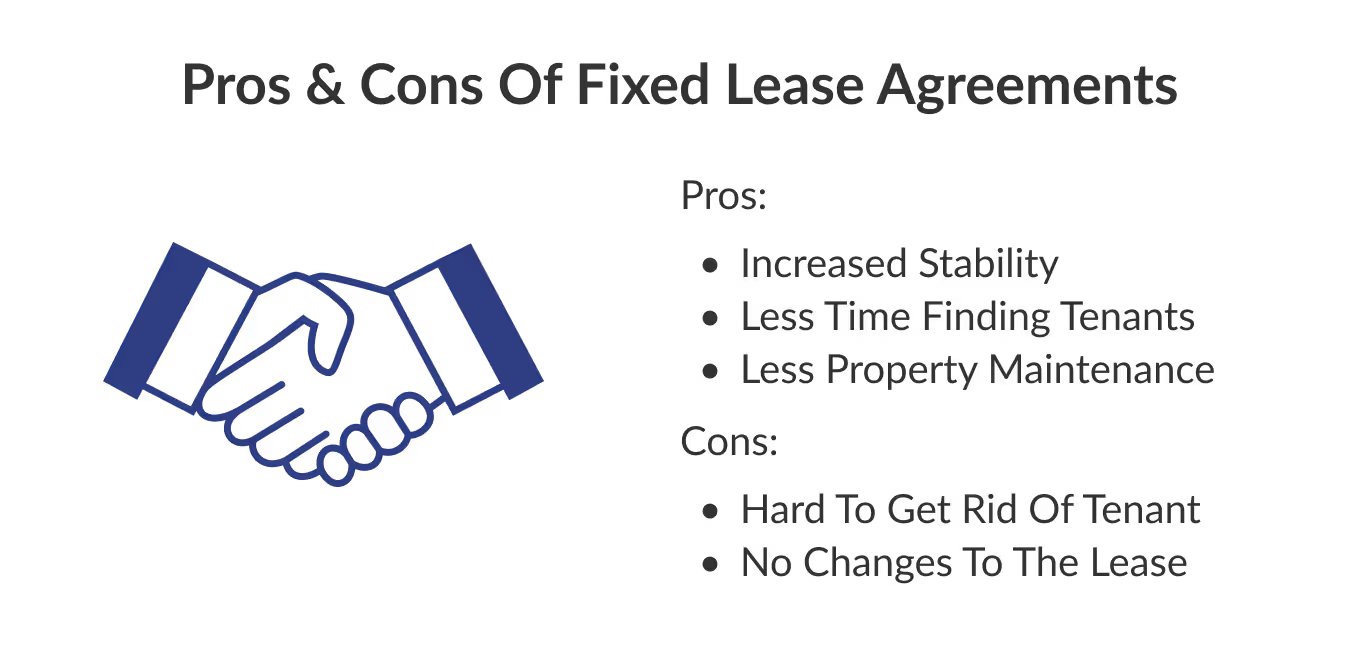As a property manager, there are so many decisions to make that it may seem overwhelming.
However, this can sometimes come in handy because it means that you have various options at your disposal.
One of the options that you have when it comes to renting out your rental property is the kind of lease agreement that you will employ.
But, which one should you choose?
In this guide, we will be going over what a month to month lease is as well as what a fixed term lease is. We will also be explaining the many pros and cons of each one.
To begin, let's go over the general meaning of each one.
What Is A Month To Month Lease?
Month-to-month leases is a short-term lease agreement.
It is– as it sounds– effective on a month-by-month basis.
That’s notable because it gives the landlord the ability to cancel the contract at any time.
It’s important to mention, however, that a month-to-month-lease agreement still requires proper notice if the tenant has been with you for more than one year in most states.
Below, we have listed some of the main reasons why someone would want to use a month to month lease.
Advantages Of Month To Month Leases

If you’re looking into month-to-month leases, chances are you already have an idea of why you’d use one.
But in case you aren’t clear on the benefits, here’s a quick summary:
Greater Flexibility
With a month-to-month lease, you can rent the property out for a shorter period of time. For example, when you’re considering a major change or move that would keep you from wanting to sign a tenant to a new 1-year lease but also want to continue collecting rent payments.
Or, similarly, when a tenant’s lease ends and they need additional time to get their new living situation setup such as beyond in the process of purchasing a home.
Changes To The Lease
With a month-to-month lease, you’re not locked into a year-long lease with a tenant at the same rent price.
And while it is difficult to retain tenants after raising rent pricing, a month-to-month lease makes it easy to bring in new tenants at higher rates.
Ending The Lease
Is your new tenant a real pain?
No problem, with a month-to-month lease you can send the tenant a 30-day notice and not have to go through with the lease renewal. This means that you can end the lease early and move on to other tenants.
No need to have to deal with a difficult tenant for a full twelve months until lease’s end with a month-to-month agreement.
Keep in mind that, although there are many advantages to monthly leases, there are also some disadvantages. Below, we will discuss some of these disadvantages.
Disadvantages Of Monthly Leases
In this section, we will explain some of the disadvantages of using a monthly rental lease.
Decreased Stability
One of the main disadvantages of using monthly leases is that, due to the shorter lease term, the landlord faces decreased stability. This is because the tenant can move out essentially at any time and the property will be left vacant.
However, since it is not too difficult to fill a property with a monthly lease, this could not be a huge problem.
Too Much Flexibility
Ideally, a landlord wants high quality tenants to remain on the property and continue renting it out for as long as possible. However, due to the flexible end dates of monthly leases, this could be hard to achieve.
Loss Of Rental Income
When you combine the two disadvantages explained above, the result is typically a loss of rental income. This is because there may be some months where the unit is vacant due to a tenant recently moving out.
What Is A Fixed Term Lease?
On the other hand, fixed term leases are meant for longer term stays that are indicated inside the lease agreements.
These agreements typically last anywhere from 6 months to a year and the lease terms differ from month to month leases. Typically, the consequences for breaking such leases are also more severe than their monthly counterparts.
For example, for a yearly lease, the tenant has to pay rent for the entire year, and it's really difficult to get out of it. However, for monthly leases, the tenant can stop paying rent as soon as the month ends.
Now, although it may sound like fixed rental agreement is much worse than a monthly one, there are some benefits. Below, we will discuss some of these benefits in detail.
Advantages Of Fixed Term Leases

In this section, we will be explaining some of the benefits of using fixed term lease agreements instead of monthly leases.
Increased Stability
One of the greatest benefits of using fixed term leases over monthly leases is the increases stability. This is because, when a tenant signs a longer term lease, they are agreeing to stay in the property and pay rent for at least 6 months.
Less Time Finding Tenants
Since the landlord only needs to find about 1 or 2 tenants a year for fixed term leases, this means that they have to spend much less time and money finding tenants.
For month to month leases, landlords have to conduct the tenant screening process on various tenants many times a year. This can become expensive and can take a lot of time from the property manager.
Also, since lease renewals are pretty common for good tenants, landlords may have one tenant for many years at a time.
Property Maintenance
Another interesting benefit of using a long term lease is that the landlord will most likely spend less money on maintenance. This is because, since the tenant is responsible for a portion of the maintenance, not as many repairs are going to be done by the landlord.
However, for monthly leases, the landlord potentially has to do maintenance every few months and spend money getting the property ready for showing or for new tenants.
So, just like with monthly leases, now let's discuss some of the disadvantages of fixed term leases.
Disadvantages Of Fixed Term Lease Agreements
In this section, we will explain some of the disadvantages of using fixed term leases over monthly leases.
Stuck With The Tenant
Let's face it, not every tenant is going to be great. This is why one of the disadvantages of fixed term lease agreements is that the property manager has to deal with the tenant for the whole lease term.
Now, the only case in which the landlord can get rid of the tenant is with an eviction, or something similar. Although these will help you get rid of unwanted tenants, they can cost a lot of money and take a long time.
No Changes To The Lease
Another disadvantage of a fixed term lease is that it is extremely difficult, sometimes impossible, to make changes to the lease after it has been signed. This can only happen after either the landlord or the tenant terminate the lease and it is offered to someone else.
Bottom Line
There is no such thing as a one-size-fits-all situation. That is why every property manager and landlord should analyze their own situation and choose which kind of lease is most appropriate for them.
































.svg)
.svg)

